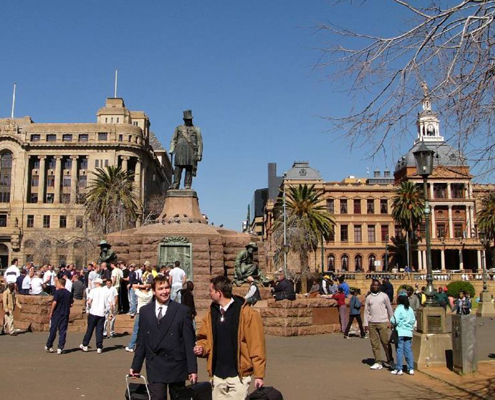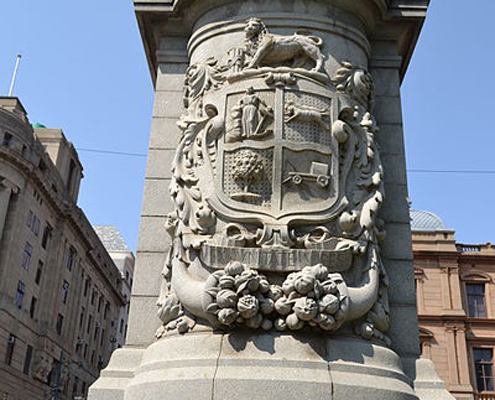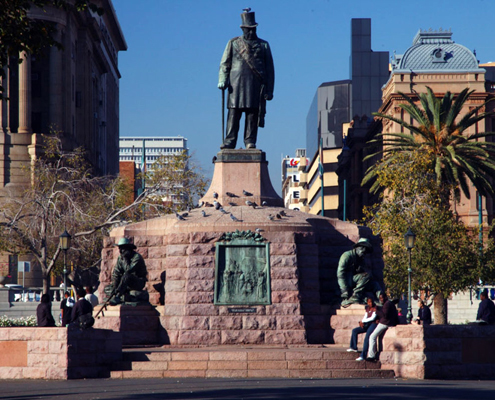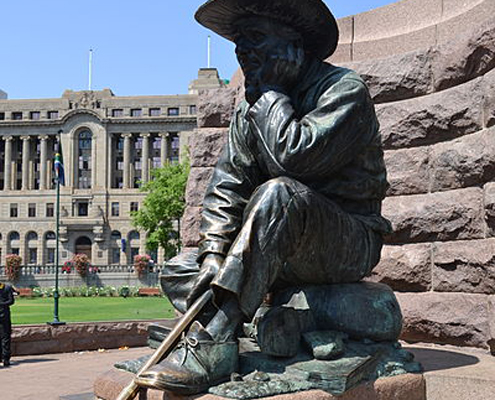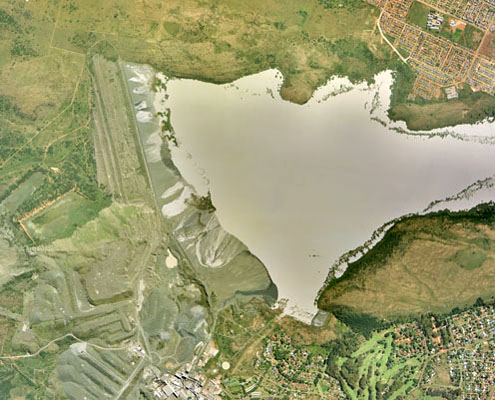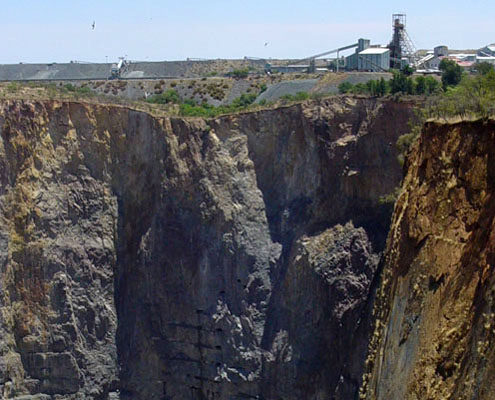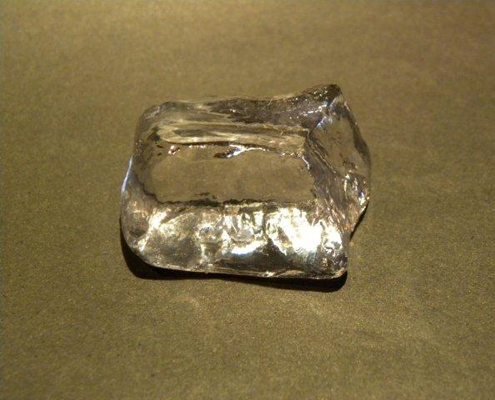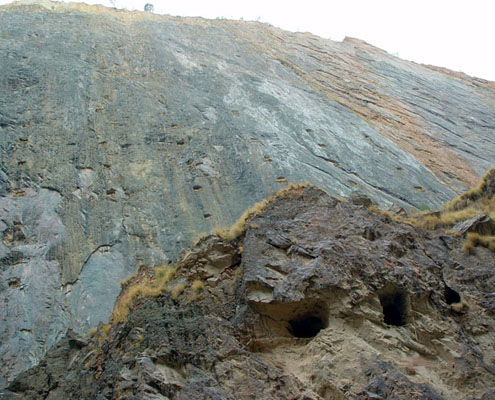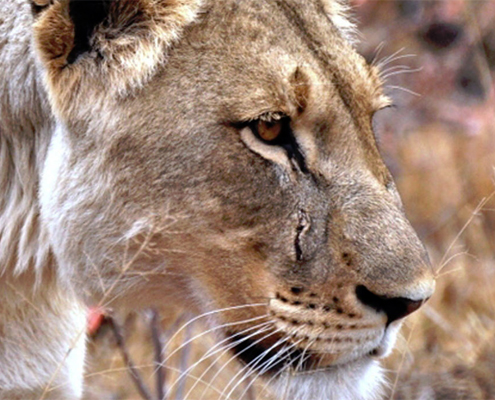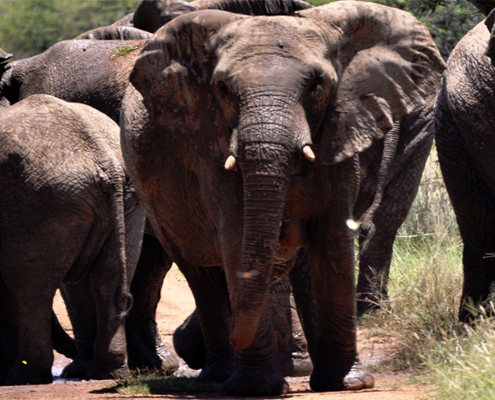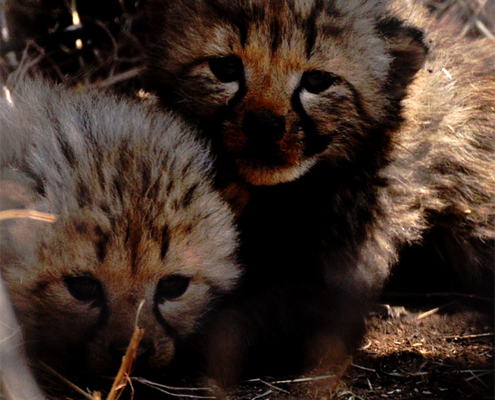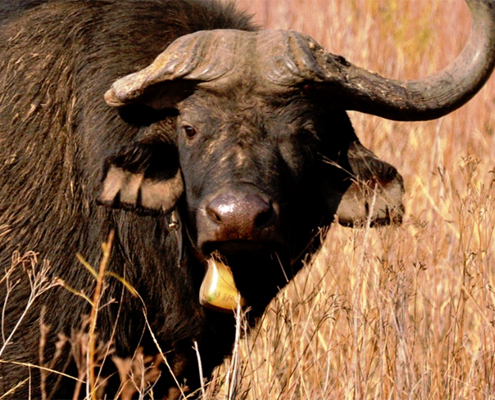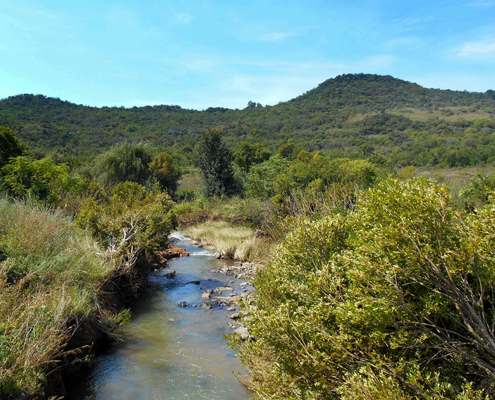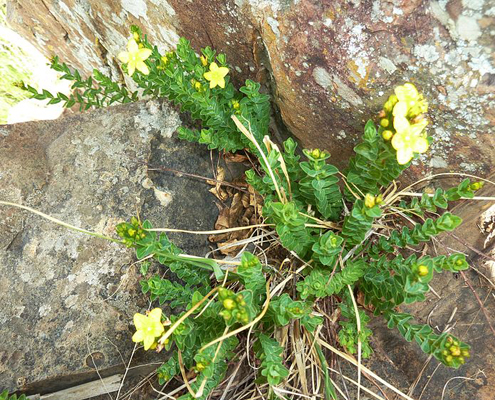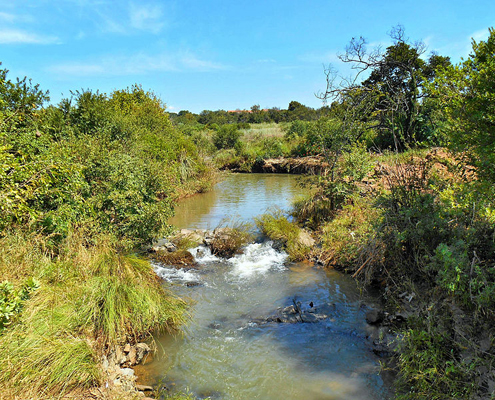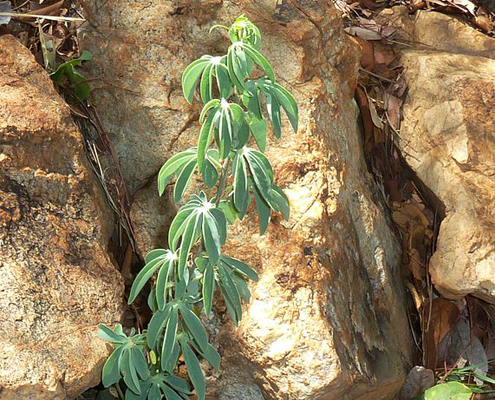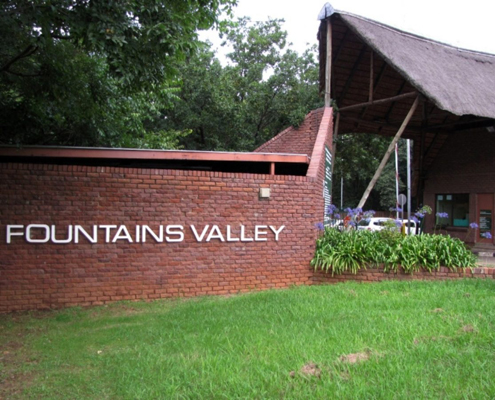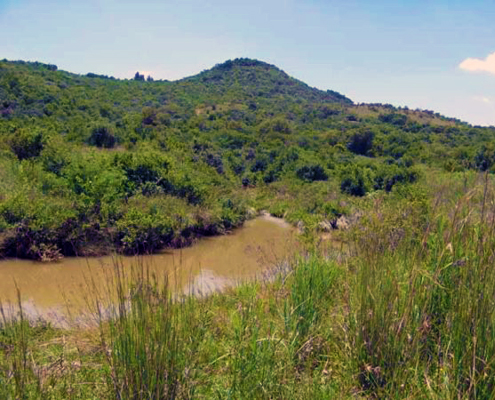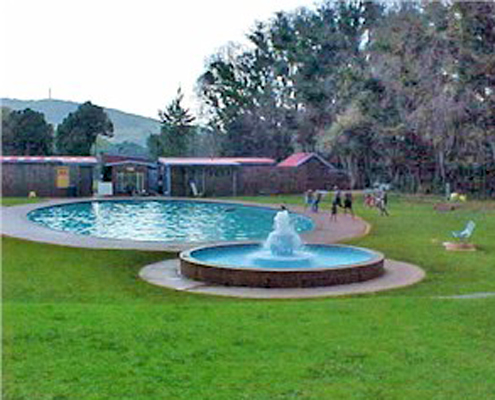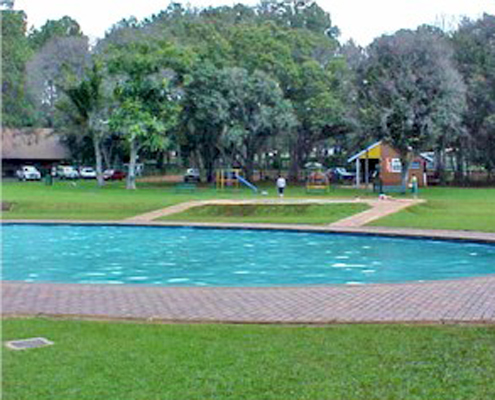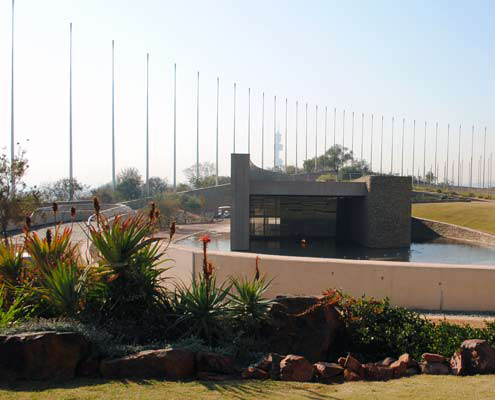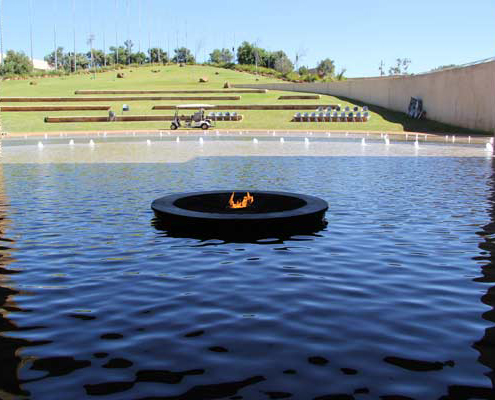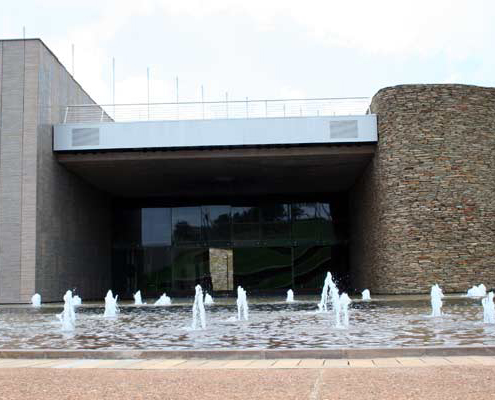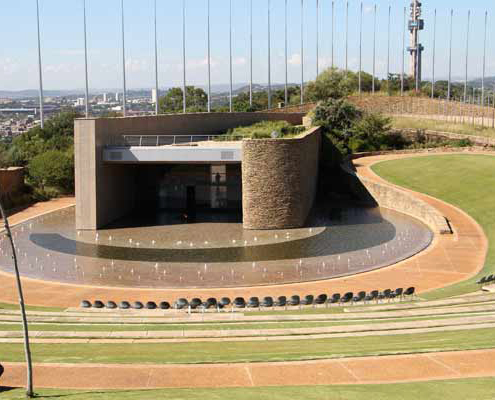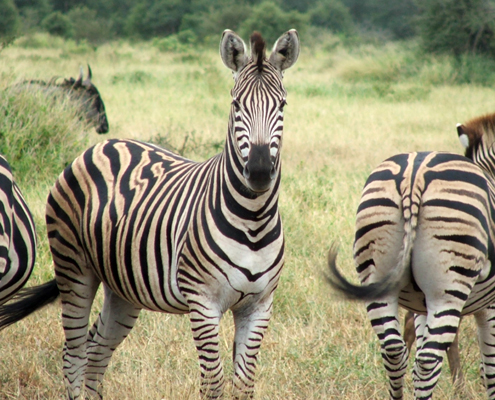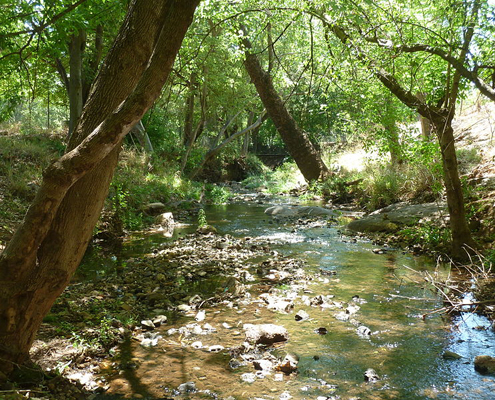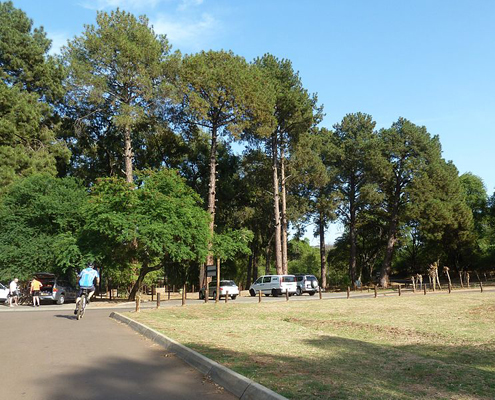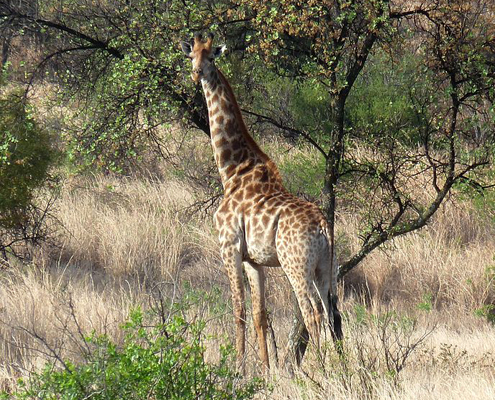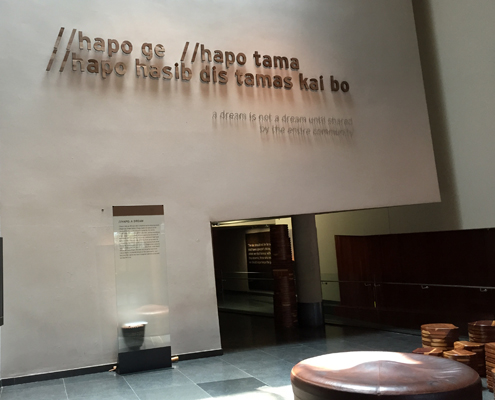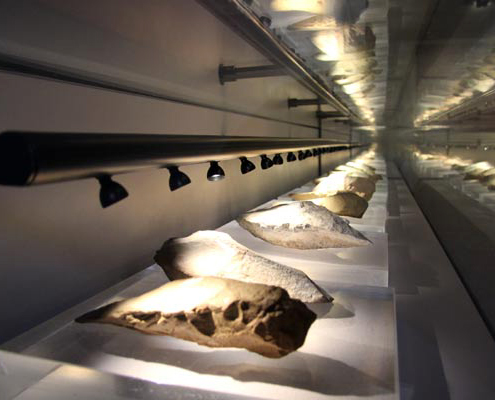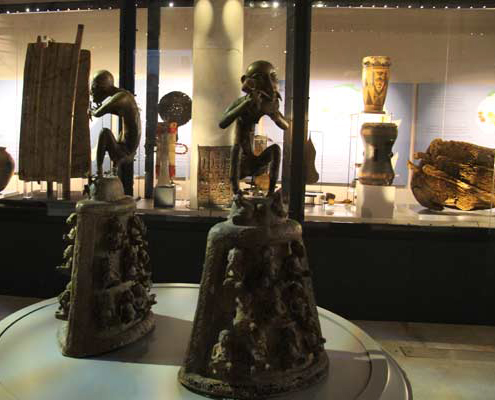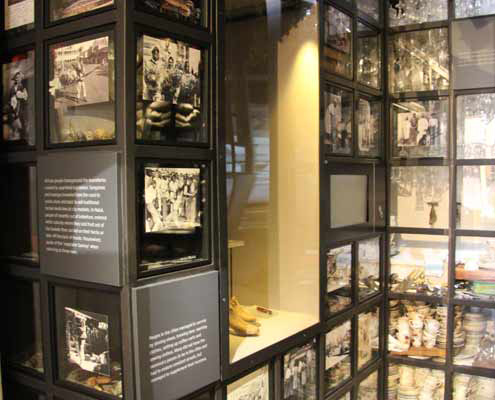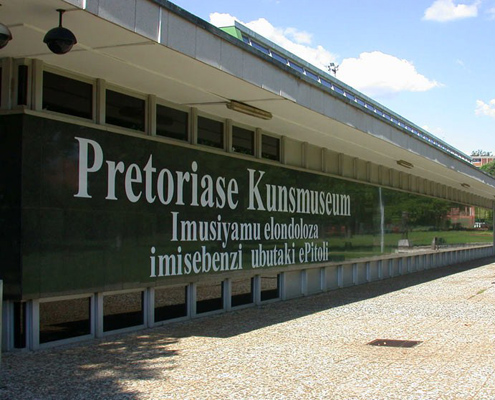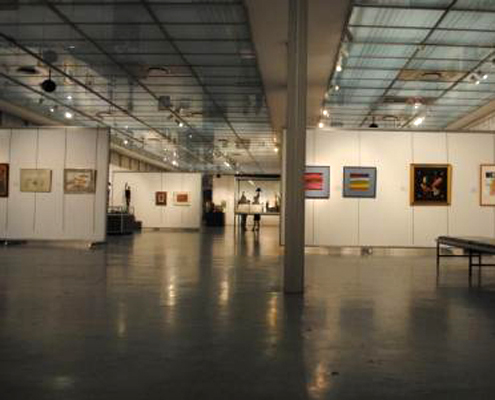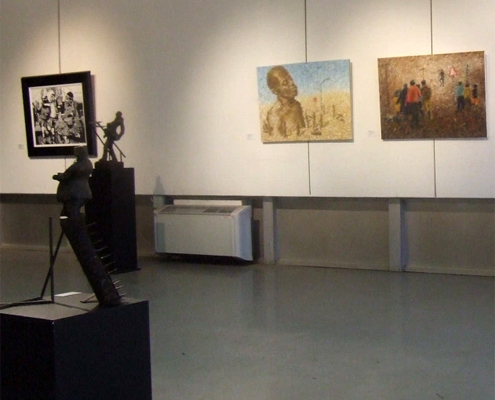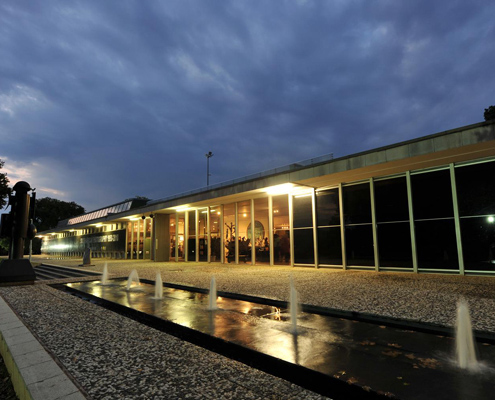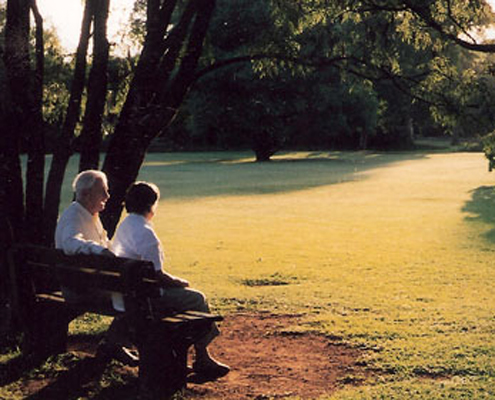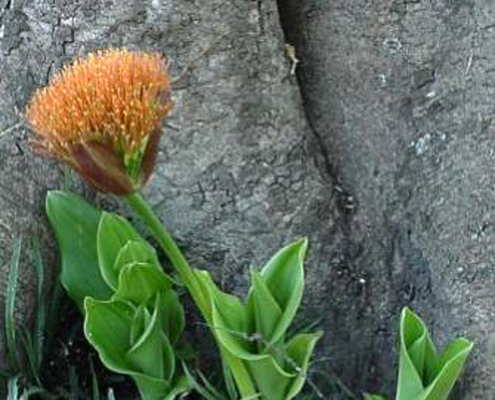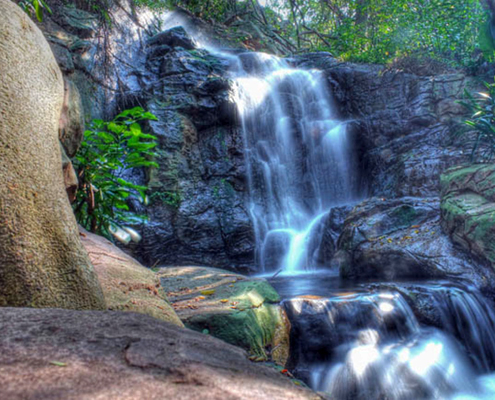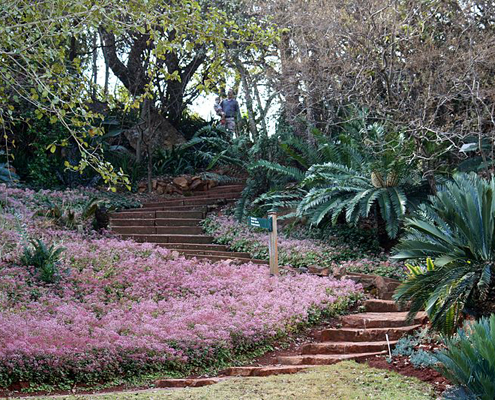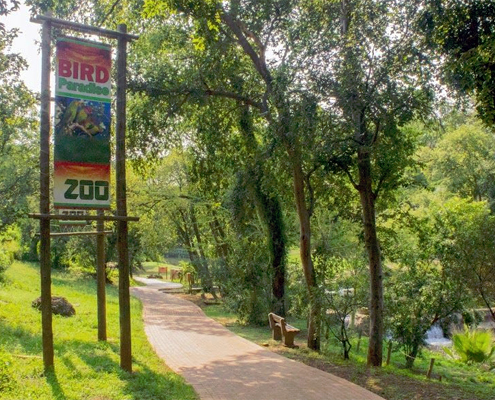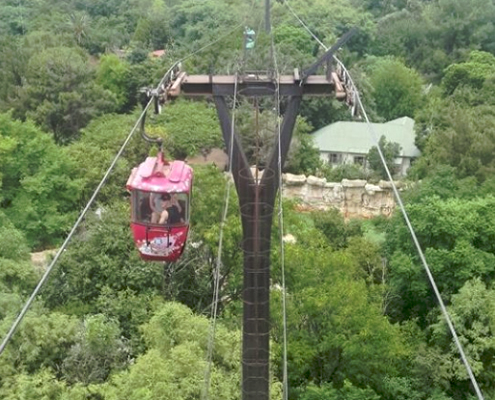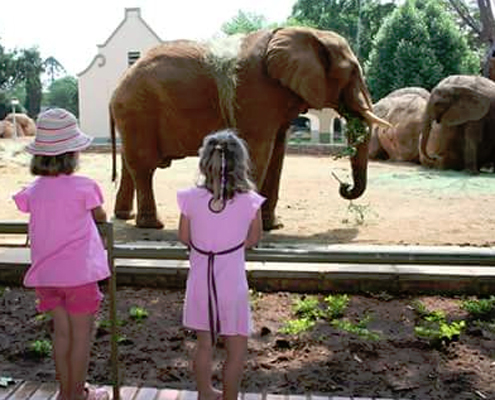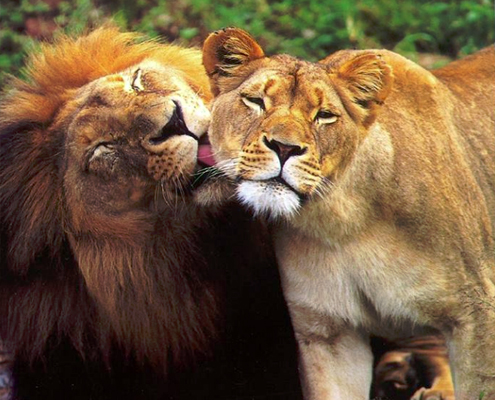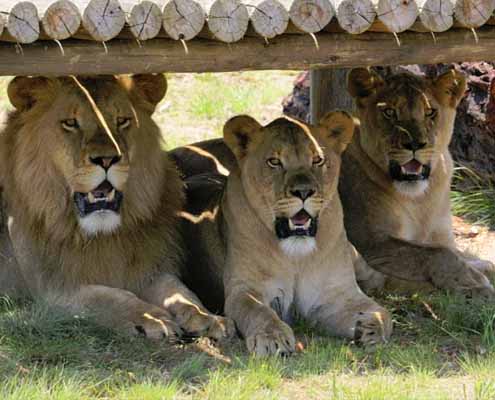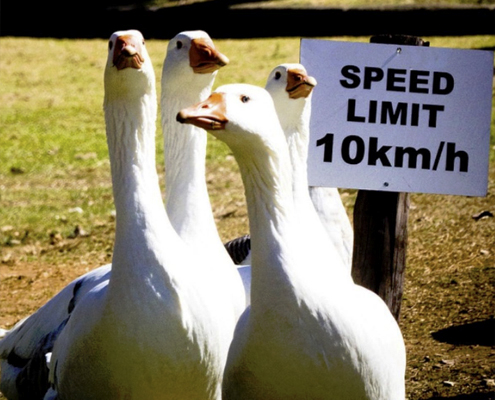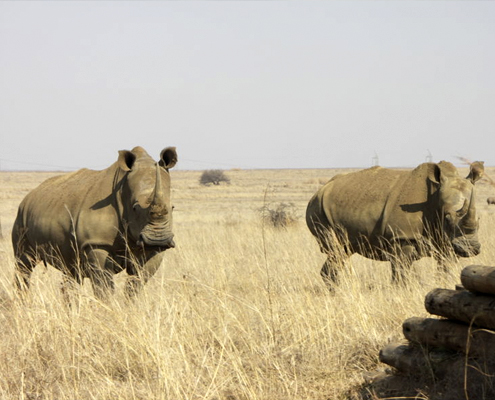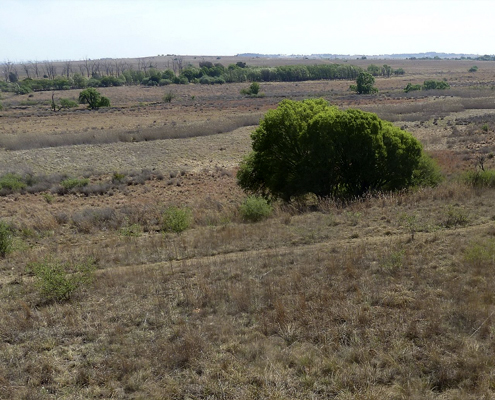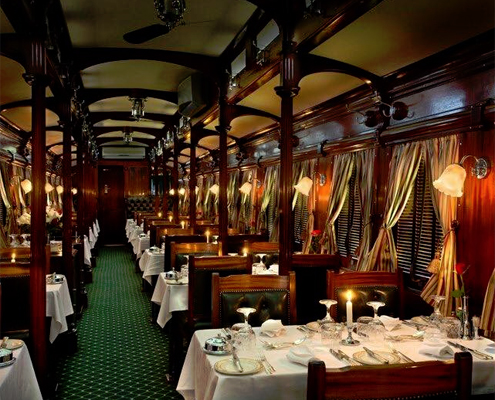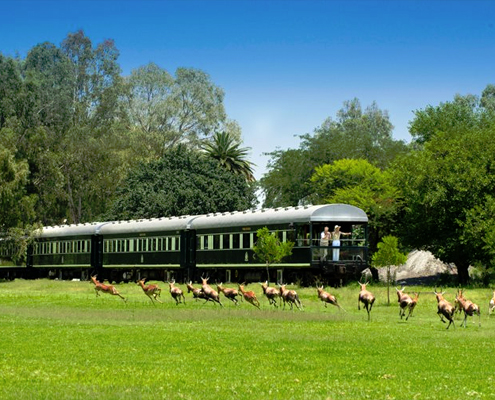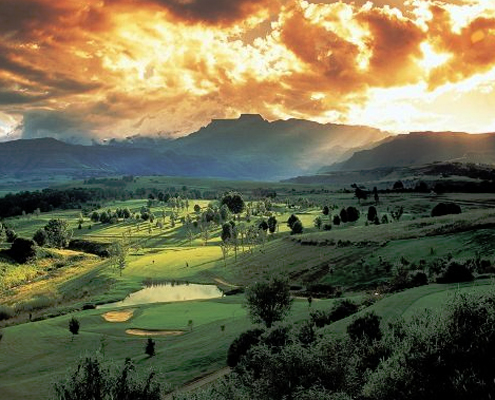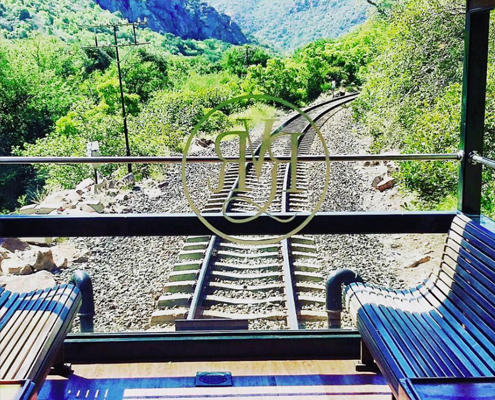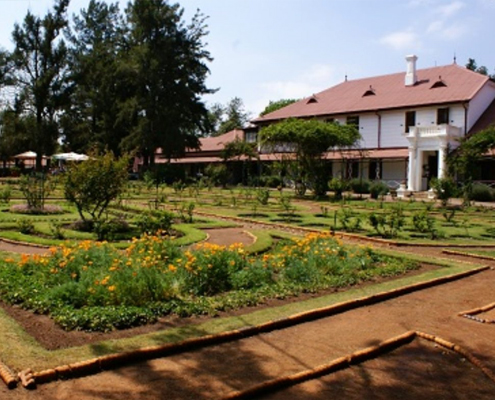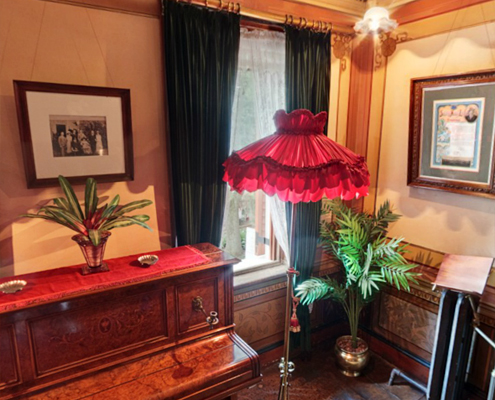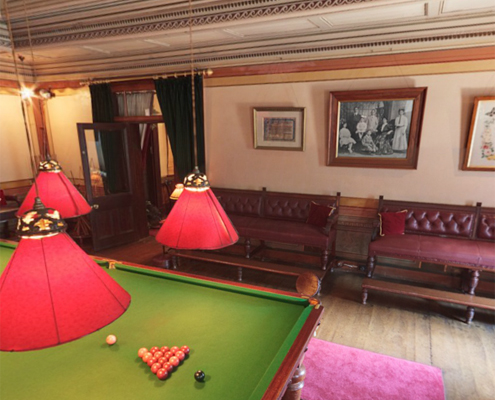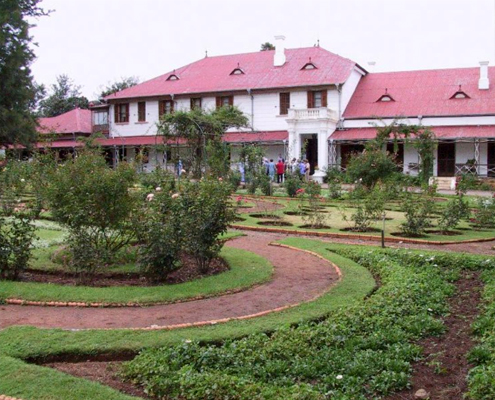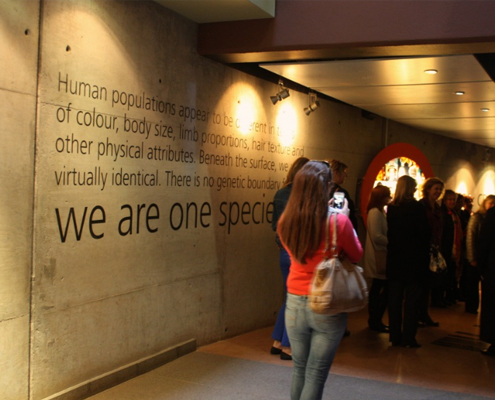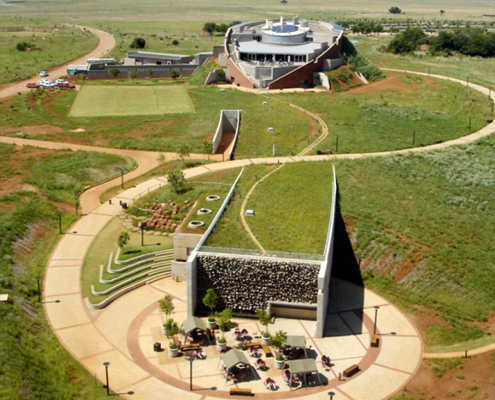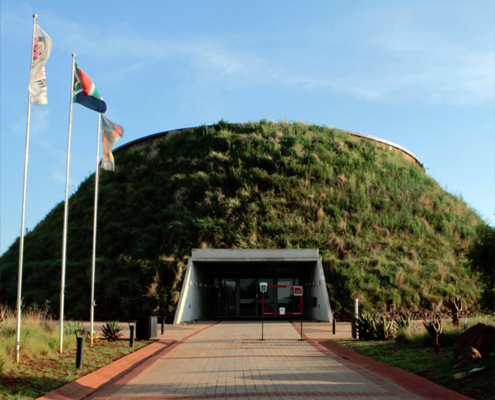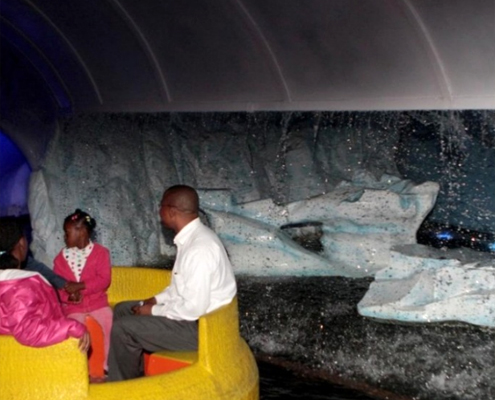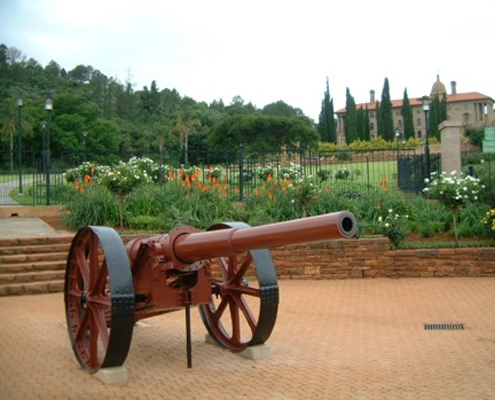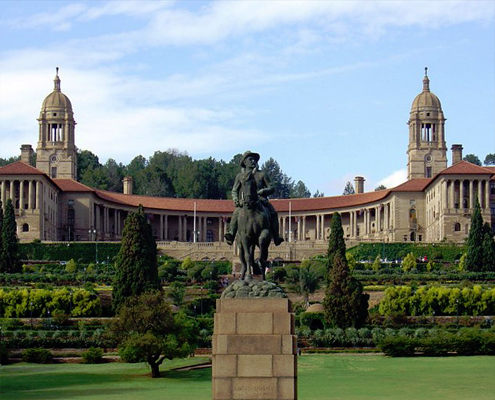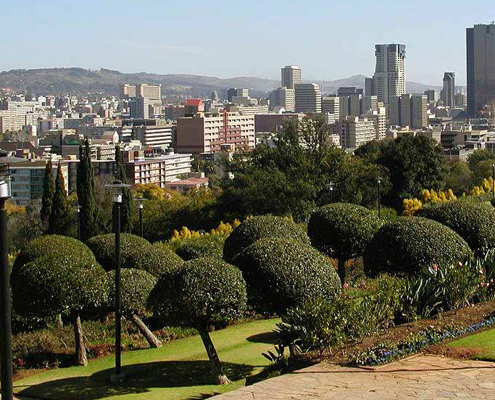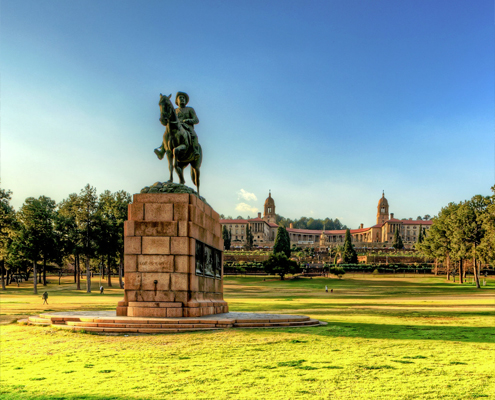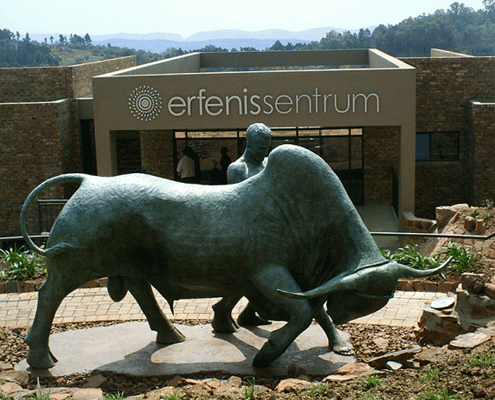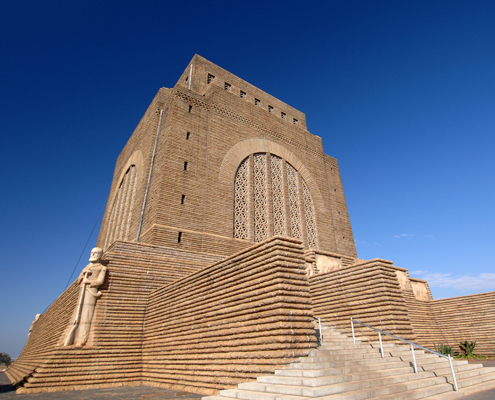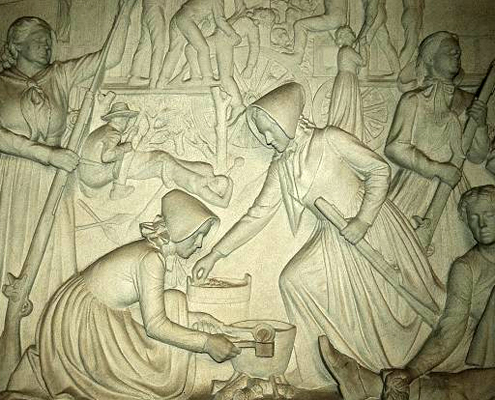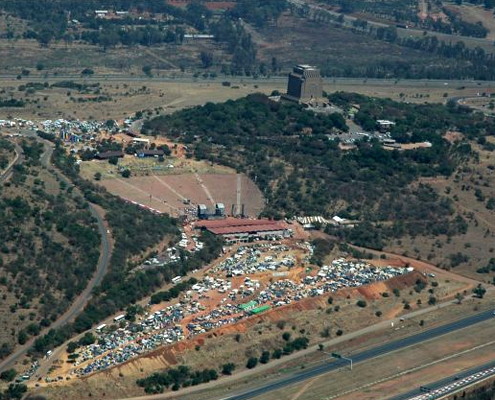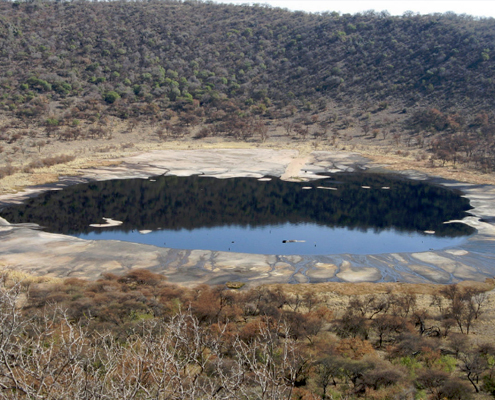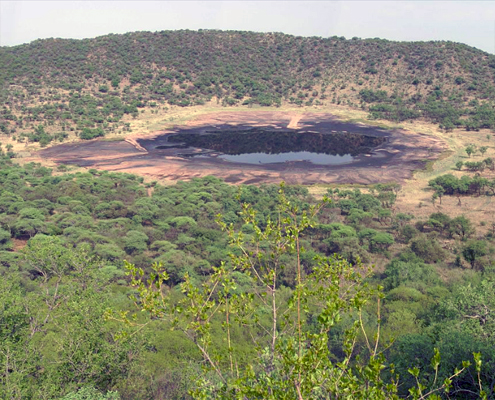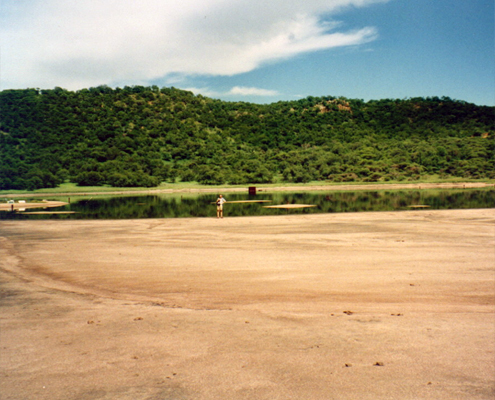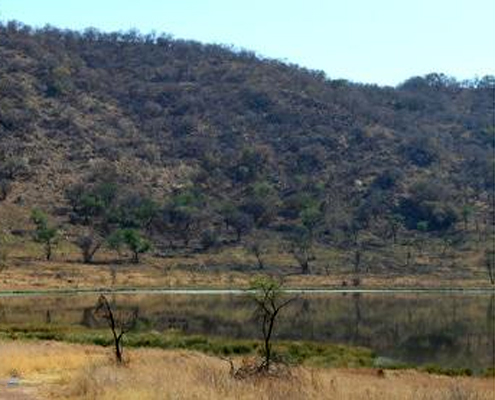Church Square & Paul Kruger Statue
Church Square in central Pretoria was the site of the city’s first church, built in 1855. During its early years, the square was used as a marketplace and sports field. Today Church Square is a relaxing spot for visitors who adore 19th-century and early 20th-century architecture, as well as those who just want to enjoy a day out with the family. It is a great place for families to sit under beautiful Jacaranda trees and feed the pigeons on a hot summer afternoon on the well-manicured lawn.
The square is surrounded by numerous historical buildings, including the Palace of Justice where former president Nelson Mandela and several of his African National Congress comrades were charged and tried for treason during the infamous Rivonia Trial. On the southern side of the square lies the Ou Raadsaal (Old Government) building and the Old Capitol Theatre which is linked to Café Riche – the oldest café and bistro in Pretoria.
Church Square is also framed by the Netherlands Banking Building (home to the offices to Tshwane Tourism) and the General Post Office, which was erected in 1910.
Former president Paul Kruger’s large bronze statue sits at the Centre of the Square. Wealthy industrialist Sammy Marks commissioned Anton van Wouw to sculpt it in 1896. The bronze statue was unveiled on Church Square in October 1954 by former Prime Minister DF Malan after it had earlier been installed in front of Princes Park and later placed in front of the Pretoria Station.
The square’s main attraction is a weekly one-hour ceremonial parade held every Wednesday between 21h30 and 22h30. The parades are done by members of the National Ceremonial Guard and accompanied by a South African military band. The procession ends with the raising of the national flag and municipal flag to the sound of the national anthem.
View more information
Cullinan Diamond Mine
Located 20 minutes’ drive east of Tshwane, the mining town of Cullinan is home to the Premier Diamond Mine, also known as the Cullinan Mine following the discovery in 1905 of the largest rough diamond in history.
The Great Star of Africa, a pear-shaped diamond of 530.20 carats, is the largest of the nine stones fashioned from the Cullinan diamond, and is the second largest cut diamond in the world. It is set in the sceptre of the Crown Jewels and is housed along with other royal jewels in the Tower of London.
The mine is the third richest diamond producer in South Africa and its functioning open pit is four times larger than the well-known Big Hole in Kimberley. The 3 106.75-carat Cullinan stone makes a not insignificant contribution to the 120-million carats that have been extracted from one of the biggest and richest kimberlite pipes in the world.
Daily tours of the mine are open to the public and explore both underground and surface operations including the mine shaft, hoist room, big hole, and the display room. This mining town has a main street filled with restaurants in beautiful old buildings reminiscent of mining town culture in the early 19th century.
View more information
Dinokeng Game Reserve
The Dinokeng Game reserve is within Tshwane located just north of the city and only an hour’s drive from O.R Tambo International Airport. The malaria–free game reserve is approximately 3000 hectors and is the only big 5 game reserve in the province with free roaming lion, elephant, leopard, cheetah and buffalo. The game reserve is also home other species of game such as the kudu, giraffe, waterbuck, blue wildebeest and many more.
Dinokeng translates to ‘place of rivers’ because it lies between rivers that flow to the Limpopo and Orange rivers. Because of all the water and wetlands the game reserve has an abundance of birdlife, making it ideal for bird-watching enthusiasts. Also on the game reserve is the protected Tamboti tree, also known as the Spirostachys African which is indigenous to South Africa.
The game reserve has about 30 lodges and ranches that offer accommodation, game drives and bush walks. Each lodge and ranch is unique with different accommodation offerings, from camping, caravan to five star and a number of licenced restaurant that offer a wide range of menus. There is an array of activities available within the game reserve including game drives, horse riding, hiking, hot air balloon rides and luxurious spa treatments.
View more information
Faerie Glen Nature Reserve
The Faerie Glen Nature Reserve in Pretoria is a popular oasis in urban surroundings, boasting idyllic scenery, an incredible abundance of birdlife and a series of nature trails and walks.
The reserve transitions between bankenveld (grassland) and sour bushveld (acacia veld), and visitors can spot South Africa’s national flower – the Protea – growing along the hillsides. The reserve also forms part of the 8km Moreleta Spruit Nature Trail, while the perennial Moreleta Spruit flows through it, responsible for abundant grassland and rich vegetation.
Birdwatchers will be in their element as there are more than 150 species of birds to look out for. Common finds include the European Nightjar, African Black Duck, Brown-backed Honeybird, European Bee-eater, Cape Grassbird, Marsh Warbler, Crimson-breasted Shrike and Village Weaver. Rare birds such as the Corncrake and River Warbler have also been spotted at the reserve, so keep those binoculars at hand.
The best time to visit if you’re interested in birdlife is in the summer season (September to April from 06:00 and 19:00). In the winter season (May to August) the reserve closes at 18:00. In addition to the large variety of birdlife, there are also rare trees and insects.
If hiking is more your cup of tea, there are several trails and walks of varying difficulty that are sure to provide you with scenic and invigorating passage through the reserve. There are also easy-to-follow footpaths and clear signage to ensure guests enjoy a comfortable and safe meander, although it is not recommended to visit the reserve alone. There are no facilities in the reserve itself, but the Plumbago Tea Garden is situated at the entrance if you’re keen for relaxing refreshments after your hike or a quiet morning spent bird watching.
View more information
Fountains Valley Resort
The Fountains Valley Resort, just outside Pretoria, is a popular recreational facility.
The Fountains Valley Resort usually bursts into life at the weekend, with people arriving to braai (barbeque) – using the convenient facilities – or picnic in the well-maintained grounds. Music festivals are occasionally held at the venue too.
Pretoria is well known for its hot summers, so visitors often come to Fountains Valley to cool off in the resort’s large, modern swimming pool. Smaller children can splash in the kiddies’ paddling pool, or play in the two designated areas. There are two tuck shops and a bar at which refreshments can be purchased. A lapa can be hired for functions.
Camping facilities are available for those who want to stay overnight at the resort. Visitors with caravans are also catered for and can escape the city and enjoy this natural setting, which is very close to the Groenkloof Nature Reserve. The resort has a 4×4 track for those looking for off-road adventures, and footpaths for those wishing to walk.
View more information
Freedom Park
Freedom Park is located in Salvokop, Tshwane. It is a site of remembrance where South Africa honours those who sacrificed their lives in the struggle for freedom.
Although no remains are kept at Freedom Park, there are some symbols that represent the heroes of South Africa’s past struggles.
The 697 metre long wall of names is inscribed with names of some of those who died in past conflicts. The wall has space for 136 000 names and more than 75 000 have been listed since 2007.
The garden of remembrance is a tranquil space for reflection and prayer, combined with monuments, statues and sculptures.
View more information
Groenkloof Nature Reserve
Situated in the Fountains Valley, Groenkloof is a stone’s throw from Pretoria CBD, Paul Kruger established the area as a reserve back in 1895 to protect it from poachers and in so doing, established South Africa’s first nature sanctuary.
Groenkloof is ideal as a gateway from busy city life and offers a number of mountain bike, horse, 4×4 and hiking trails as well as guided 4×4 safaris through the park. The reserve has activities for visitors of all ages; game viewing, outdoor sporting activities and overnight trails, as well as youth camping facilities that host up to 60 people.
Overnight hikes or guided horse-trails are a great way to experience the reserve. Impala, kudu, blue wildebeest, ostrich, giraffe, red hartebeest and an abundance of bird-life can all be spotted in the reserve, whether you’re on horseback or in the back of a game-truck.
View more information
Hapo Museum
The Hapo Museum located within Freedom Park draws its name from the Khoi word meaning ‘dream’ and tells the story of Africa in a seven parts called Epochs.
The seven part of the story are Earth, Ancestors, Peopling, Resistance and Colonisation, Industrialisation and Urbanisation, Nationalism and Struggle, National Building and Continent Building.
The story starts 3.6 million years ago with African creation legends, and describes the continent’s, and South Africa’s, rich and colourful history. It combines indigenous African knowledge and contemporary scientific thought to bring history to life. This story of the nation’s rich and colourful history unfolds in seven eras.
The Hapo Museum also explores the great questions – who am I and why am I here? What comes before and after death?
View more information
Pretoria Art Museum
Located in Arcadia, the Pretoria Art Museum, taking up the impressive entirety of a city block, was originally built to hold the city Council of Pretoria’s art collection which has been built up since the 30’s. Due to other museums already having fine collections of European art, it was decided the Pretoria Art Museum would focus primarily on South African work, including pieces by renowned figures in the art world such as the country’s Old Masters; Hugo Naude, Henk Pierneef, Irma Stern and Maggie Loubser. International art is acquired to a lesser extent, with mainly prints being on display. The museum offers major exhibitions functions as an educational facility, offering guided tours and a children’s gallery for learners to broaden their knowledge of the arts.
Guided tours for group of a minimum of 10 people are offered when pre-booked. One option covering South Africa art is run at 10h00 and 13h00, and lasts an hour. Up to 100 learners can be accommodated.
View more information
Pretoria National Botanical Garden
Embark on a floral journey of discovery at the Pretoria National Botanical Garden, a treasure chest of South African flowering plant species and trees.
The flagship area of the garden is the indigenous garden, which comprises savannah, forest and fynbos biomes – man-made habitats that support specific plant species that are not endemic to the area, but which are indigenous to South Africa.
The Pretoria National Botanical Garden, located in Brummeria, Tshwane, was established in 1946 after the University of Pretoria’s experimental farm and private properties to the north of the city were acquired by the Department of Agriculture.
Special features at the garden include an avenue of wisteria trees and collections of medicinal plants, cycads, aloes, tree species, succulents and natural ridge vegetation. Although the focus here is on flora, the bounty of plants has attracted around 200 bird species, as well as reptiles and small mammals.
Seasonal attractions enjoyed by visitors include rolling green lawns and spreading shade trees in summer, while winter highlights include a blaze of flowering aloes.
The garden’s Mokha restaurant features a deck overlooking the wetland. Mokha is a superb venue for breakfast, lunch and dinner, and also caters for functions such as weddings.
Large tour groups are welcome at the garden, where plenty of parking is available for buses. Disabled access is provided. The Eco Craft Gift Shop, situated in the new visitor centre near the main entrance, sells a wide range of African curios and gifts. Guided walks and guided tours of the medicinal garden may be arranged for up to 20 people at a time.
View more information
National Zoological Gardens
South Africa’s National Zoological Gardens in Tshwane, houses over 8 000 animals, reptiles, fish and birds, is the largest zoo in the country – and the only one with national status.
The original zoological gardens, founded in 1899 by the then-director of the Staatsmuseum (“State Museum”), Dr Jan Gunning, comprised a collection of birds and a few mammals that were transferred to Rus in Urbe farm following the outbreak of the Anglo-Boer war.
The zoo received national status in 1916 under Dr Alwin Haager. Although the facility didn’t have the funds to purchase animals, it was used as a stopover point for animals being transported from Africa to Europe and America. In this way, local residents were able to view animals from regions outside South Africa.
The Pretoria Zoo offers a full day out for visitors of all ages. Pay a visit to the South African fur seals, gorilla enclosure, the aquarium, reptile park and the endangered Komodo dragon.
Navigate the zoo’s various paths by golf cart, hire children’s fun pushcarts, or catch the Zoo Choo-Choo train. A particularly popular feature is the cableway, which takes visitors on a seven-minute ride to the mountain top.
There are numerous picnic spots throughout the Zoo, where you can relax in the shade of giant trees. Braai (barbeque) facilities are available at the picnic area next to the Apies River or, if you prefer, you can sample the cafeteria’s wide variety of delicious takeaways, enjoy a sit-down meal at the licensed restaurant, or grab a snack at one of the zoo’s four kiosks.
View more information
Rietvlei Nature Reserve
Situated 18km from the centre of Pretoria, the 3 800-hectare Rietvlei Nature Reserve surrounds the magnificent Rietvlei Dam which supplies Pretoria with 15% of its water.
The reserve comprises endangered Bankenveld grassland and is home to approximately 2 000 animals ranging from cheetah, leopard, buffalo, white rhino and a host of buck. The bird watching is remarkable with two dams on the reserve with bird hides which provide open water and wetland habitats.
Activities at the dam include freshwater fishing (catfish, yellowfish, carp and Tilapia), which is allowed at the northern and western shores and a variety of non-motorised water sports, which operate from the yacht club, located on the north-western shore.
Guided one- and two-day hiking and horse trails are available and there are a number of braai and picnic spots available. Game drives and night tours are available with a qualified guide, but visitors must provide their own vehicles. Campsites, huts and chalets are available for overnight stays.
Guided night drives – rounded off with a braai under the stars – expose visitors to the delights of nocturnal species such as the brown hyena, black-backed jackal, ant bear, aardwolf, porcupine, springhare and bush pig.
Three distinct habitats – grassland, open-water and wetland – make Rietvlei excellent for bird watching and both dams feature bird hides. Popular with visitors is the lovely picnic area at Marais Dam, an ideal location to while away an afternoon under the trees while watching water birds and hippos.
View more information
Rovos Rail
Since its establishment in 1989, Rovos Rail has earned an international reputation for its truly world-class travel experiences. Step aboard the wood-panelled coaches – classics remodelled and refurbished to mint condition – and enjoy fine cuisine in five-star luxury as some of the most varied scenery imaginable unfolds beyond the windows.
Pride of place in the Rovos stable goes to the historic and newly rebuilt station and locomotive yard in Pretoria, which is the heart and headquarters of this private railway company. From here, successful charters from one to 10 days have been undertaken with incentive groups, historical tours, private gatherings and bird shoots.
The trains – which may be hauled by steam, diesel or electric locomotives at various stages of the journey – carry a maximum of 72 passengers in 36 superbly appointed suites. Within reason and subject to availability, the chartered train can go wherever there is a railway line in Southern Africa.
Recapture the romance and atmosphere of a bygone era when privileged travellers experienced the magic and mystery of Africa in a relaxed and elegant fashion.
View more information
Sammy Marks Museum
The Sammy Marks Museum is a Victorian mansion called Zwartkoppies Hall, situated about 23km outside Pretoria.
The estate originally belonged to 19th century agricultural, industrial and mining tycoon Sammy Marks, who lived there with his wife, Bertha, and nine children.
A tour of the estate today will give visitors insight into the splendour and opulence of the time. Each of the 48 rooms is furnished with exquisite porcelain, paintings and silver – evidence of Marks’ status in society.
The house also has a well-stocked library, with books covering everything from history, mining, agriculture, farming and horticulture to religion, industry, fiction and poetry. The size of the library is evidence of the family’s emphasis on education.
View more information
The Maropeng Visitor Centre (Magaliesberg)
The Maropeng visitor centre is one of South Africa’s eight world heritage sites and the official visitor site for the Cradle of Humankind. The centre’s world-class exhibition provides visitors with an overview of human ancestry over the past few years.
Du Toit notes that not only is Maropeng a very attractive option for meeting planners to add-on to their conference, but it can also be combined with a trip to the Sterkfontein caves in which lies fossils that date back more than four million years.
“If you want to try and make the whole experience a bit more different and exciting you could include a hot air balloon ride over Magaliesberg and ride over Maropeng,” says Du Toit. Alternatively, you could add on a canopy tour of your trip to the area.”
View more information
The Union Buildings
The Union Buildings which house the offices of the president of South Africa are together with the site’s amphitheatre, one of the most recognisable landmarks in Gauteng.
The national monument has become synonymous with South Africa’s transition to democracy and as such is an interesting site for delegates to visit.
While visitors are not allowed access to the buildings themselves, picturesque gardens make for a tranquil picnic spot.
Du Toit advises that a trip to the Union buildings be combined with additional elements in order to make the experience a bit more engaging.
View more information
The Voortrekker Monument
The Voortrekker Monument is another historical attraction which represents an integral part of South African history, and is definitely worth a visit.
The massive granite structure is a national heritage site and also happens to be one of the world’s longest historical marble friezes. It commemorates the Voortrekker’s and their epic journey from the Cape Colony through to the Highveld.
A museum has also been set up in the basement of the monument along with a curio shop where guests can purchase souvenirs.
Today it is the most visited heritage site of its kind in Gauteng and one of the top ten cultural historical visitor attractions in the country.
View more information
Tswaing Crater
Located about 40km (25mi) northwest of the city centre of Pretoria, Tswaing is a conservation area that is home to a meteorite impact crater and surrounding wetland, as well as the remains of an old salt factory. Tswaing, which means “place of salt” in Setswana, is the site where a meteorite half a football field in size slammed into the Earth 220 000 years ago, forming a crater 1.4km (1mi) in diameter and 200m (660ft) deep. This crater, formerly known as the Pretoria Saltpan (or Zoutpan), is one of about 170 impact craters in the world and one of four known impact craters in South Africa.
Just east of the crater is the Soutpanspruit, which feeds a rare wetland system that is home to game, a large number of bird species, smaller mammals such as otters, genets, brown hyenas, civets and steenbok, reptiles and frogs.
The Tswaing Crater site boasts one of only four meteorite crater museums in the world. Visitors are encouraged to take the 7.2km Tswaing Crater Trail, one of three trails that lead to and from the crater rim, and peruse the museum display. The site guided walks and education programmes.
View more information

